The making of Narendra Modi
- Published
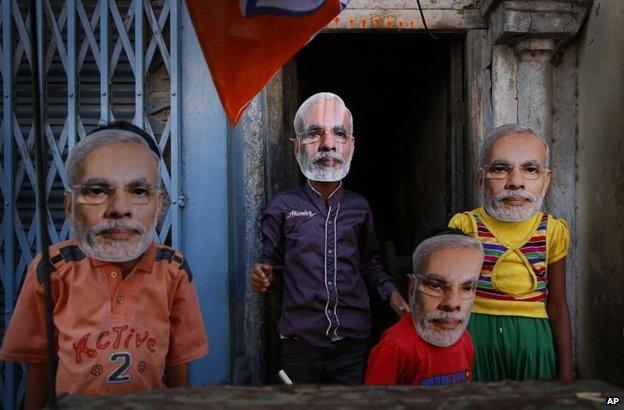
Narendra Modi is seen as a dynamic and efficient leader
Flanked by grim-looking security guards, Narendra Modi walks up briskly to the podium, tosses a glance at local party leaders waiting in the oppressive heat, and launches into his speech.
Mr Modi, the man who many believe will be India's next prime minister, is, clearly, in a hurry.
On the stump, the leader of the main opposition BJP wastes no time in tearing into his rivals, the Congress party. His speech is a mix of rousing rhetoric and snappy slogans and sends the crowd into raptures.
"The Congress party says that a Modi wave could turn into a tsunami which will destroy. Yes, there will be a tsunami, my friends, and it will be a Modi tsunami which will destroy the Congress," says Mr Modi, who loves using the third person.
He pauses for a moment, takes in the applause and quickly comes to the point, one hand on his hip, the other gripping the mike.
"Do you want an MP or a PM? If you want an MP, vote for Congress, if you want a PM vote BJP. And if your son is sitting in Delhi, you don't have to worry about anything," he says.
Approval
Several thousand supporters packed under a vast white-and-blue tent in Modasa, a small town in Gujarat's sprawling district of Sabarkantha, roar in frenzied approval.
A scream rises from a bubbling cauldron of expectations: "Yes, yes, we will send you to Delhi!"
Mr Modi mocks the Congress government for not being able to control inflation and govern efficiently. He promises more lucrative prices to farmers for their crops, better roads, and more irrigated farms if voted to power.
And then, as swiftly as he arrived, he's gone.
Gujarat is the only state in India where the BJP has been in power continuously since 1998 and won over half of the total seats in the last six elections. In 2012, the party registered its fifth consecutive win in the state polls - its third under Mr Modi. He has been the chief minister of this western state for 12 years now.
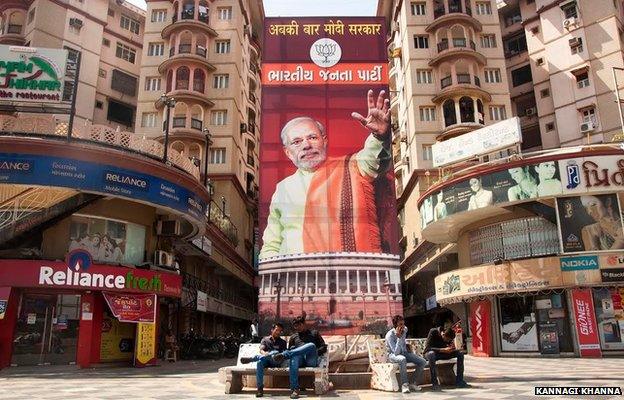
Mr Modi looms over Gujarat, the state he has ruled for over a decade
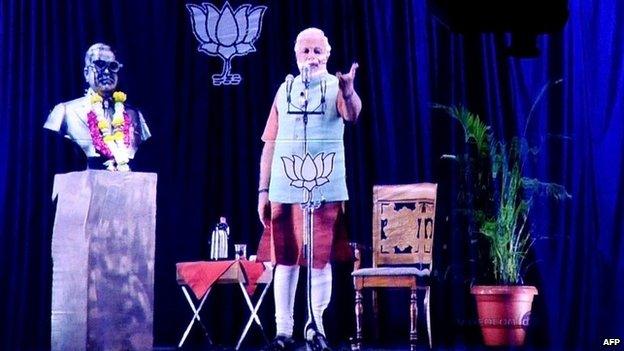
Mr Modi has used holograms to appear at several public meetings at the same time
Among the believers, there is a blithe sense of assuredness that Mr Modi will deliver to India what his predecessor Manmohan Singh, a reticent 81-year-old technocrat, couldn't: decisive and corruption-free governance.
Twenty-eight-year-old soldier Chirag Patel is one of them. He says he has taken two months of leave to campaign for Mr Modi, and is an example of the fierce loyalty that he evokes among his supporters.
"I will only return to work after he becomes the PM. He will make India like Gujarat. He has given us 24 hours electricity for homes, eight hours for farms, good roads. There's been complete peace - after the 2002 riots," he says.
The riots remain a stain on Mr Modi's reputation - over 1,000 people, mainly Muslims, died - and his critics say he did little to stop the violence, and has steadfastly refused to apologise. Muslims comprise nearly 10% of Gujarat's population, but Mr Modi's party doesn't have a single Muslim legislator.
Perplexing
But this hasn't stopped his popularity from growing, especially among the young in his state and across India.
His supporters say they like Mr Modi for his flamboyance, oratory ("What lines, what dialogue!," 18-year-old Rahul Vaghela told me in Ahmedabad), the fact that he lives alone and "doesn't have a family to enrich like other Indian politicians", and his image as a hard taskmaster. Journalist and author Fareed Zakaria calls him "charismatic, intense, utterly decisive"., external
Mr Modi has staked his claim to the top job in India mainly by flaunting his credentials as an efficient ruler of one of India's most economically prosperous and business friendly states.
Making impressive strides in farming and infrastructure, Gujarat has clocked double-digit growth under Mr Modi. But the jury is still out on whether the fruits of the growth have reached the most underprivileged among its 60 million people.
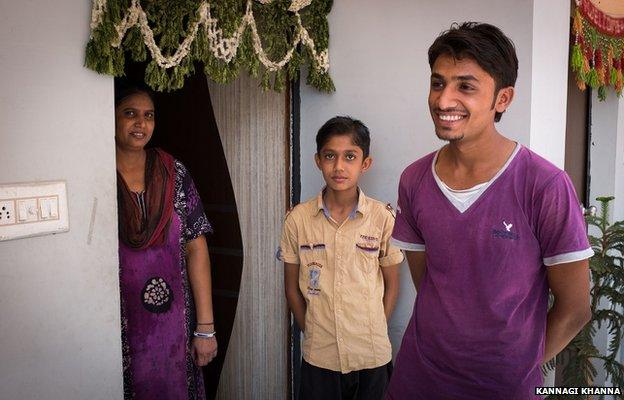
Rahul Vaghela (right), 18, says he likes Mr Modi because of his 'brilliant oratory'
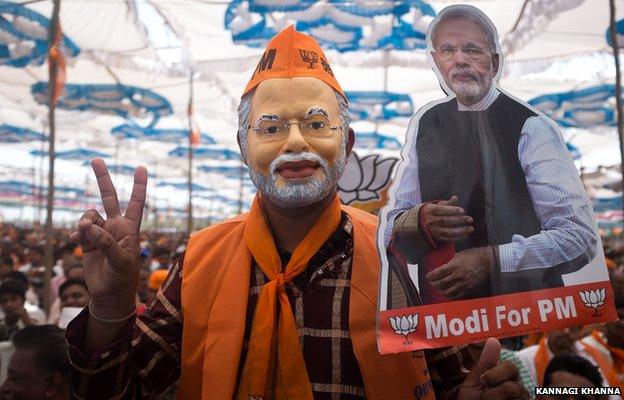
Alpesh Patel (wearing a Modi mask), a cotton farmer, says his life improved after Mr Modi came to power in Gujarat
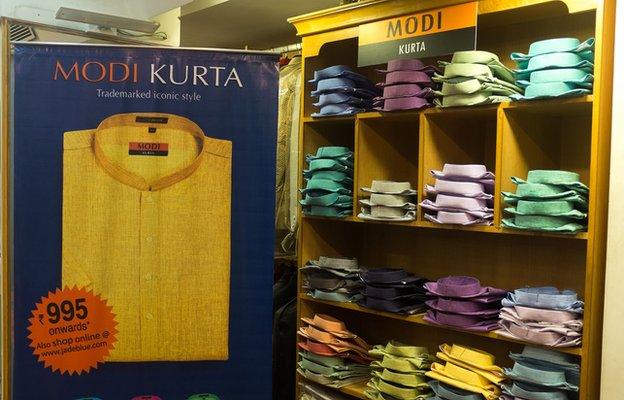
There is even a line of tunics named after Mr Modi
Many say that for a state which ranks so high in growth and ease of doing business, it's perplexing that it remains in the middle of the rankings when it comes to education, health, female literacy and financial inclusion. "Is this high growth with low development, external model indicative of the priorities of the government of Gujarat? Or is it something else altogether?" wonder economists Ashok Kotwal and Arka Roy Chowdhury.
Many believe luck has also played a role in Mr Modi's meteoric rise.
His predecessor, Keshubhai Patel, who was in power between 1998 and 2001, had to cope with a cyclone, two major droughts and a devastating earthquake., external
Mr Modi's rule in Gujarat - despite the shadow of the riots and a number of alleged extra-judicial killings by security forces - coincided with the boom years of India's economy. Abundant rain, the growing benefits of a water pipeline from the Narmada river, and a smart move to cash crops like cotton all contributed to high farm growth. Federal funds have helped beef up infrastructure for which many say Mr Modi takes credit.
It also helps that 43% of Gujarat is urbanised: tens of thousands of migrant workers flock to the state. "For many of these workers from India's poorest states, Gujarat looks like a paradise. They return home with stories about its good roads and availability of jobs," says one analyst who does not want to be named.
Mr Modi's supporters have also carefully cultivated a cult of the BJP leader as a self-made no-nonsense ruler who rose from humble beginnings as a son of tea-shop seller. The cult of Mr Modi has been built over the years, say analysts, as he began harbouring "national ambitions".
In 2008, adverts announcing the opening of compressed natural gas stations in Gujarat appeared with Mr Modi's picture and the slogan: My Dream: Green India. Next year, some of India's top tycoons hailed him as a "future prime minister". An unapologetic advocate of strident Hindu nationalism, Mr Modi has been described as a "King of Hindu hearts" and a man with a "56-inch-chest".
Over the years, his face has been in adverts and on billboards, food packets, cheap lunch packs for schoolchildren and even condoms distributed by the government, external during an HIV campaign.
'Mesmerising'
After the BJP announced last September that Mr Modi would be the party's prime ministerial candidate, he has inundated the airwaves, making it almost a presidential-style referendum on his leadership under the gaze of some 400 news networks.
His supporters wear masks, caps, paper sunglasses and scarves bearing his face. There are Modi flash drives and photo books. Scores of films have been made on him and his work and more than 120 books have been written about him, many of them hagiographies with names like The Architect of a Modern State and The Man of The Moment. An animation film commissioned by a fan club in Gujarat shows Mr Modi as a Superman-like figure throwing darts at a "poverty board" and swooping in to catch terrorists.
A comic book claims to reprise Mr Modi's childhood stories, including an astonishing one of returning a baby crocodile to a village lake after his mother admonished him for plucking it out of the water and bringing it home. And the leader even inspired an eponymous line of colourful tunics called Modi kurtas which fly off the shelves at a premier local clothing chain. "His skill in selling dreams and slogans to mesmerise people is unparalleled in contemporary Indian politics," says sociologist Ghanshyam Shah.

Modi pen drives are available in Gujarat
During the campaign, the indefatigable leader, external - his party reckons he will have travelled some 300,000km (18,641 miles) across India and spoken at 437 public meetings by the time the elections end - has communicated to voters through tea-shop meetings using multiple video links and holograms. These allow him to "appear" at a number of rallies at the same time.
"He's reduced everything to himself," Mahesh Langa, a senior journalist in Ahmedabad, tells me. "He's the state, he's the party, he's the government."
People who have worked with his government say Mr Modi prefers to depend on a team of handpicked bureaucrats rather than his ministers in getting work done. He brings in young professionals to work as interns in the government. He holds regular away-days with bureaucrats in resorts where, according to one participant, he "listens intently to deliberations, takes notes and never nods off to sleep".
"He's very focused, works very hard and gives the impression of a man with a mission," says one bureaucrat, who is critical of his record in the riots.
In the end, no politician, in recent history, has divided India like Mr Modi.
His supporters regard him as some sort of a messiah who can return India to high growth and a position of prestige and strength. His critics - and many of them include some of India's most distinguished thinkers, writers and academics - believe he threatens the idea of a plural India. "Whatever people might say," says BJP leader Arun Jaitley, "Mr Modi has succeeded in communicating directly to the people."
How far the people have responded will be known soon.